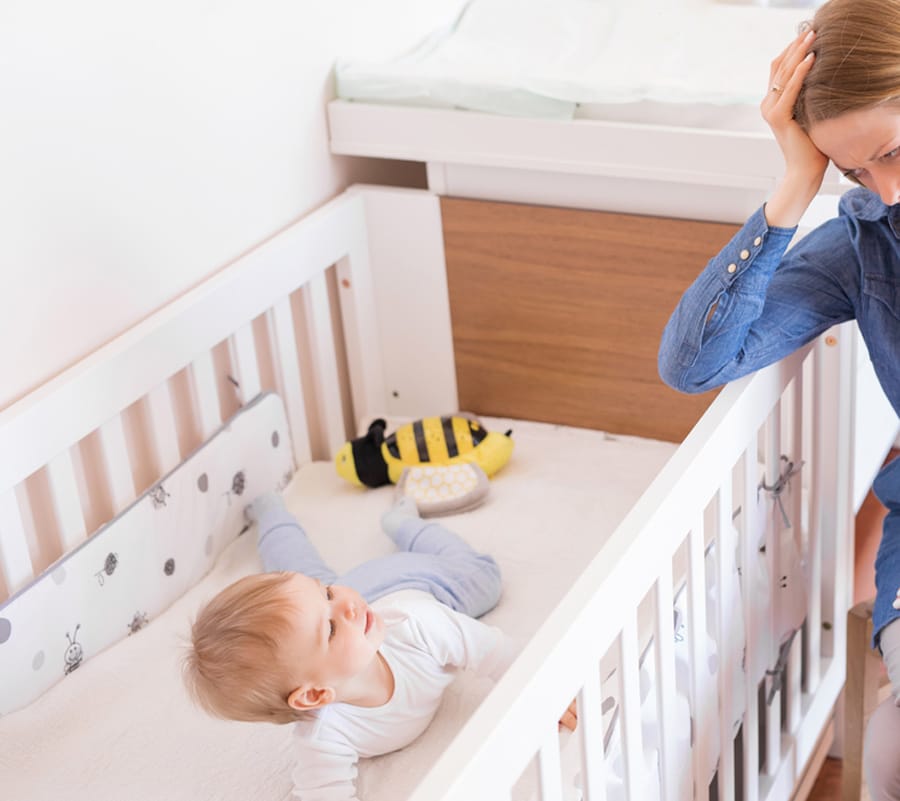It’s not always easy to get a baby or child to go to sleep on their own. So, which method works?
First things first: I really, strongly, dislike the terminology “sleep training.” I am not a sleep trainer, and I do not sleep train my clients’ kids.
Call it semantics if you will, but to me, sleep training sounds like a boot camp. CIO. 3 nights. Done. Brush off your hands, and you’ve got perfect little angels.
But kids aren’t microwaveable. And as we all know, as soon as you get one thing tucked neatly away, you’re dealing with the next thing.
Working with your children’s sleep is not going to be a do-it-and-done sort of deal. There’s usually going to be an initial investment period—whether that’s by gently molding them in the newborn stage, or implementing something a little bit stronger later on (as infants, toddlers, preschoolers or even older!)—and then things will gently roll into a status quo.
But it’ll still take skill, knowledge, and sometimes patience on your part to be able to sustain the changes that you’ve made.
With that behind us, let’s tackle the details: the methods and what they mean.
Most sleep books and blogs boil down to one of three methods: Extinction, Leave and Check, or Stay in the Room.
Extinction (or, Cry It Out – CIO)
How it works: Put your baby (who does not know how to self-soothe) down in the crib, walk out and close the door. Leave baby in the room until morning, without any check-ins or removing baby from the crib.
Some more info: This is what most people think of when they hear “sleep training,” and is very controversial. Some say this is the “easiest” way to get their baby to sleep, while others cannot fathom the idea of leaving their baby crying for an extended period of time without being present for them. Many parents find it hard to stick to it, and after 20 minutes of crying, 1 hour of crying, or even on the second night, end up reverting to the old habits.
This method should NEVER be used for children below the age of 6 months (adjusted when necessary).
Some poskim will tell parents not to follow this method, as it can cause desensitization to their children’s crying.
Leave and Check (or, Ferberizing)
How it works: Put your baby (who does not know how to self soothe) down in the crib. So long as she is crying, you will spend some of the time in the room, and some of the time out of the room.
Some more info: This is the second most common method people think of when they hear of sleep training, and is called, by some, “controlled crying.”
This is the method that Dr. Richard Ferber advocates in his book, “Solve Your Child’s Sleep Problems.” I have found that lengthening the time between check-ins, which is what he recommends, is unnecessary when implementing this.
This method should never be implemented with children below 4 months of age, and used with caution between 4-6 months (adjusted when necessary).
Stay in the Room

How it works: Put your baby down in the crib, or tuck your child into bed. Pull up a chair next to him, and sit with him as he falls asleep. Do not take him out of his crib, but use occasional touch, and voice to reassure him. As the nights pass and he becomes more proficient, slowly move your chair away from him and out of the room so that he is not dependent on your presence to fall asleep.
Some more info: While many sleep books and sleep consultants advocate and implement this method, if you’ve read Kim West’s “Good Night Sleep Tight,” you will be familiar with this as “the sleep lady shuffle.”
When parents do use this method, they should be careful that their child does not become dependent on their presence to fall asleep.
My View
To begin, I don’t like Extinction or CIO for a couple reasons:
First, it does not align with my parenting philosophy. While I am a proponent of giving children the space to learn new skills and practice independence when age-appropriate, I also believe that it’s our job to support our children during difficult times and learning periods. This doesn’t mean solving our children’s problems for them, it means being present, comforting, empathizing, and encouraging. Total extinction takes the parents out of the picture entirely while the child is learning a new and difficult skill.
Second, it’s very hard to sustain. While some parents do successfully sleep train their babies with CIO, many end up caving to their baby’s cries. This is really not fair to the baby, who now has learned that he needs to cry to get what he believes he needs, and is also very confused by the inconsistency.
So what do I use? Well, it depends. I don’t think that there is a one-size-fits all method (if there was, you’d never see any new sleep books being published!), so I really customize my plans to the family’s needs.
When working with newborns, I don’t use any of these. Newborns are a lot more “moldable,” so we work to gently build healthy habits rather than attack old ones.
With infants and toddlers/children in beds, I’ll usually err to the side of Stay In the Room, and with younger toddlers who are still in cribs, I often start off with Leave and Check.
When you’re deciding what works best for your family, though, it’s important to take any other factors into account. What’s your child’s temperament? Is she going to be too stimulated by your presence? Do you have any other children or obligations you need to be attending to during night and nap time that will make one method unfeasible? How about your level of comfort hearing your child cry?
Weighing your options and discussing them with your husband to make sure you’re both totally on board with the method you’ve chosen is key—because the only way to see the results you want to is with 100% consistency.
Some other things to keep in mind
Bedtime and nighttime do not exist in a vacuum. It’s important to implement the other foundational pieces of healthy sleep skills (routines, wake time limits, etc.) in order to set your child up for success.
I also want you to remember that we adults often impose our own views and feelings on our children’s realities, but that does not mean that’s what a baby is actually feeling. Your baby does not know what a jail is. And your baby does not think that, when you put her down for the night in a crib, you are locking her in jail. Cribs are the safest place for our children to be sleeping until they are developmentally ready to remain in a bed that does not physically constrain them (usually between 2.5-3.5 years of age). Help your child develop a positive association with bedtime and her crib so that she will learn to love sleep—and even ask for it when she knows that’s what she needs.
[If you feel like you need a little more guidance and support in choosing and implementing the best method for your family, shoot me an email or give me a call – I offer a complimentary Discovery Call, and would love to discuss working with you!]





I used the Ferber method on my 3.5 month old baby when he only knew how to be nursed to sleep and I was losing my milk. It was absolutely the hardest thing for me as a new mother but after a week or so my baby learnt to love his crib at nighttime and even for naps. Over a year later he still loves going into his crib and night and almost never cries past bedtime unless something is really bothering him. I’m glad I implemented the method when I did, but did I do something wrong for my baby’s development Shifra?
Hi Rivka,
In a nutshell: I’d venture to guess your baby’s probably fine.
The long answer is that no two babies are the same, and even when we have a spectrum of “norm,” some babies fall outside of that spectrum. I gave 4 months as cutoff is because that is when babies develop understanding of the concept of object permanence – that when you leave the room, you *do* still exist. As with all developmental milestones, however, that’s something that develops over time, and some babies can develop that earlier than the typical milestone timeframe.
If your baby has a healthy sense of trust and love, it’s not something I’d be too worried about, but I would recommend you keep those guidelines in mind for the future 🙂
Best,
Shifra
There is a more middle of the road philosophy and I love Tracy Hogg’s method. Her book “baby whisperer” is a must read for parents that want to do the right thing but want a stable home.
Agreed. Tracy Hogg is the healthiest method out there. It just makes so much sense. She uses a method called PU PD which stands for pick up put down. Child feels safe, not betrayed, and it really really works. Of course your husband needs to be on board cuz without consistency, the whole method goes down the drain
I read her book during my 9th month in all my pregnancies to refresh my memory. Its a life changing method. The “dream feed” idea is also fabulous
Hi CS and Rachel,
I’m glad that Tracy Hogg’s method worked for you!
In my work with clients, I’ve found that PUPD generally backfires when used with babies beyond the 10 week mark (that’s when babies have developed expectations, so when they’re put back down, they become even more confused and upset), which is why I’ve left it out of my overview of methods.
It is, of course, of utmost importance that our children feel safe throughout their childhood. As you (CS) mentioned in your first comment, consistency is key — but not just to prevent the method from going “down the drain”. Consistency is what makes any parenting method effective, because consistency is what makes our children feel safe. When we, their parents, provide a predictable set of guidelines and boundaries and regular routines, our children feel safe. They know what our expectations are of them, and they know how we’re going to act and react.
When it comes to our children’s sleep, it’s definitely a case of “different strokes for different folks.” (In theory, I’d love to co-sleep — I just don’t get any sleep that way, so it doesn’t work for me, but I know other people that it works great for!)
Every child is unique and every family is different – and I’m so glad that you’ve found the way that works best for you! It’s just not fair to all the other (different!) mothers out there (for whom Tracy Hogg wouldn’t work) to dismiss the other, equally “stable” and “healthy”, methods that work best for them. Only *you* know what’s best for *your* children.
Thanks so much for reading and commenting!
Best,
Shifra
I used the HWL method from ‘how to teach a baby to fall asleep alone’ guide by Susan Urban. It took me 3 days to teach my LO to fall asleep on his own after 7 montgh of rocking to sleep. I love the way the author speaks to you and walks you through everything. This was recommended to me by my sister and cousin and I will recommend it to everybody else as well.
Thank you Barbara for sharing the title of Susan Urban’s guide. I thought nothing would help. I got this ebook and within a week it worked wonders. I was sure that I wouldn’t decide to have more kids, but I changed my mind because a child’s sleep doesn’t have to be a nightmare. Now I know it.
oh and the HWL method is very very similar to Tracy Hogg’s but Urban’s guide gave me step by step isntructions and only 19 pages to read instead of 200!
Susan Urban’s guide is AMAZING! Finally some clear instructions that make sense. We succeed after only 3 days. Much MUCH faster than we expected. Big thanks for sharing. Love this short guide 🙂
Hi Barbara and Chloe,
So glad you found the method that works for you!
Happy Sleeping!
Shifra
This is the healthiest method out there. It just makes so much sense. Child feels safe, not betrayed, and it really really works. Thanks Barbara for sharing 🙂
This was by far one of the most helpful books I have ever read. It’s an easy and short read and I loved the guide because it’s so clear, clever and simple in it’s method. If you have a baby, you need to buy this. Sleep problems solved by reading this up. Thanks
Susan Urban is the best! I used that method and now I’m reading next one. It’s so well written and simple to follow!
Melly, what next? I used Susan’s breastfeeding guide and also sleep training method, both very satisfying. I kind of forgot about her though, is there something new?
There is more! I’ve bought the six-pack 😉 I wanted breastfeeding and sleeptraining, cause this I’m gonna need soon, but it was cheap enough to buy a pack.
I’m in HWL-team too! Just 3 nights of training and I finally got my nights back. Don’t get me wrong, I really love being a mom but being a mom with sleeping-through-night baby is even 100times better! This guide is just amazing.
Yeah, you definitely should add Susan’s HWL method to this post. I’ve just finished the training (encouraged by internet comments like these!) and I am amazed with the result! We stopped rocking and the naps finally make sense to us.
Hi!
Any tips for a baby that awakes so early no matter what? I am talking about before 6am. Tried later bedtime but failed. Baby is 18 months.